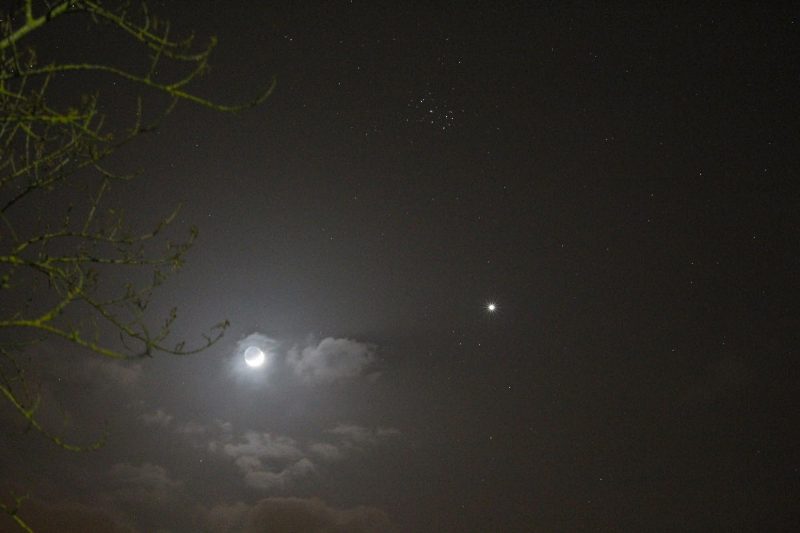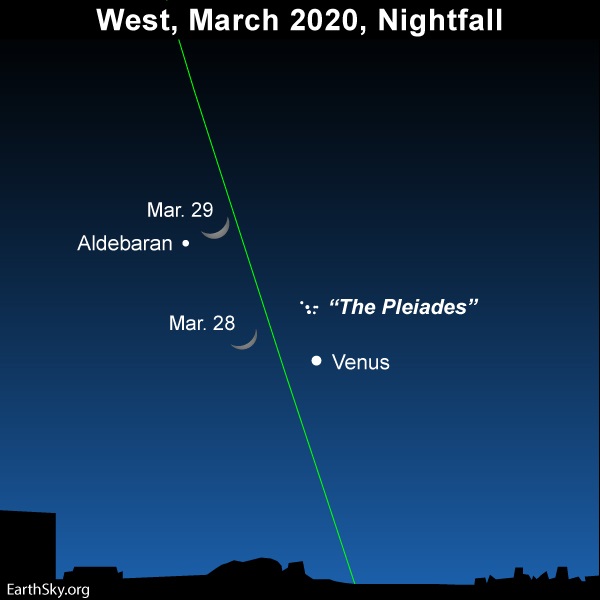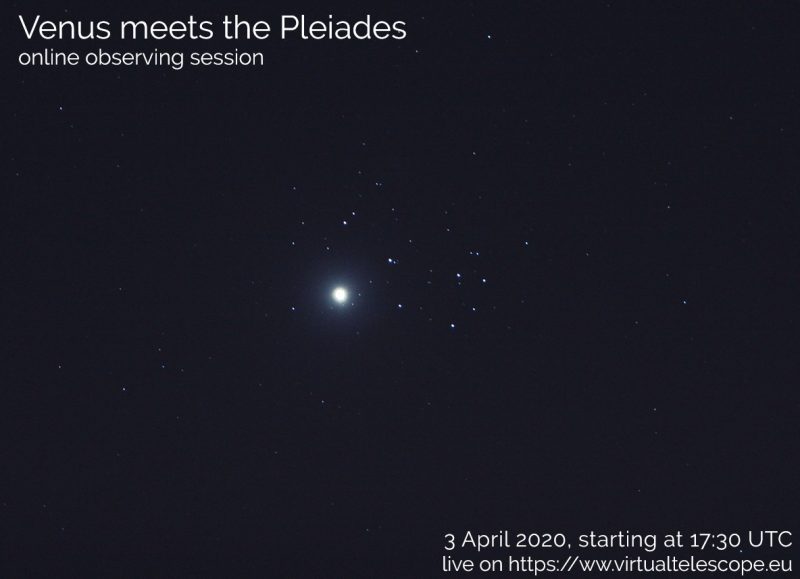

Astronomer Alessandro Marchini – director of the Astronomical Observatory at the University of Siena in Italy – wrote last night (March 28, 2020): “Stargazing from my backyard this evening, with the wonderful triangle with the crescent moon, Venus and the Pleiades (1.3 light-second, 5.5 light-minutes, 445 light-years away each from Earth). Photographed with my Canon Camera and a 100 mm lens on a tripod.” Thank you, Alessandro!
In the coming week week, you’ll be able to watch something special in the evening sky, using just your eyes. Venus – the brightest planet, the dazzling “evening star” in the west after sunset now – is about to pass the beautiful Pleiades star cluster, also known as the Seven Sisters. They will be a heart-warming sight in the evening twilight all week. As it happens – and as you can see from Alessandro Marchini’s photo above – the waxing crescent moon has just passed Venus. At EarthSky’s Tonight page, we’ve been following the progress of the moon past Venus for some evenings now. Here’s a chart for tonight, March 29.

Read more about the moon and Venus tonight – March 29, 2020 – at EarthSky Tonight.
Gianluca Masi at the Virtual Telescope is also gearing up to present the Venus-Pleiades conjunction to you online. He wrote to EarthSky this weekend:
In the coming week week, the sky will offer us something unique, coming back every 8 years only: a stunning conjunction, involving planet Venus, the brightest object up there these evenings and the wonderful Pleiades, a spectacular star cluster, one of the best gems of the deep sky. To bring some joy from this cosmic show to people worldwide, often quarantined to limit the dissemination of Covid-19, the Virtual Telescope will share this celestial treasure with everyone, offering a live view covering the climax of this cosmic hug between Venus and the Pleiades.
Click into the Virtual Telescope’s site to learn more.

Poster of the upcoming online event – April 3, 2020 – presented by Gianluca Masi of the Virtual Telescope Project in Rome. Read more about the Virtual Telescope’s April 3 online event. And notice the times are in UTC; here’s how to translate UTC to your time.
Bottom line: Venus and the Pleiades will be beautiful in the evening sky – west after sunset – all week. Their conjunction is April 3, 2020.
from EarthSky https://ift.tt/2WMUJ3Y


Astronomer Alessandro Marchini – director of the Astronomical Observatory at the University of Siena in Italy – wrote last night (March 28, 2020): “Stargazing from my backyard this evening, with the wonderful triangle with the crescent moon, Venus and the Pleiades (1.3 light-second, 5.5 light-minutes, 445 light-years away each from Earth). Photographed with my Canon Camera and a 100 mm lens on a tripod.” Thank you, Alessandro!
In the coming week week, you’ll be able to watch something special in the evening sky, using just your eyes. Venus – the brightest planet, the dazzling “evening star” in the west after sunset now – is about to pass the beautiful Pleiades star cluster, also known as the Seven Sisters. They will be a heart-warming sight in the evening twilight all week. As it happens – and as you can see from Alessandro Marchini’s photo above – the waxing crescent moon has just passed Venus. At EarthSky’s Tonight page, we’ve been following the progress of the moon past Venus for some evenings now. Here’s a chart for tonight, March 29.

Read more about the moon and Venus tonight – March 29, 2020 – at EarthSky Tonight.
Gianluca Masi at the Virtual Telescope is also gearing up to present the Venus-Pleiades conjunction to you online. He wrote to EarthSky this weekend:
In the coming week week, the sky will offer us something unique, coming back every 8 years only: a stunning conjunction, involving planet Venus, the brightest object up there these evenings and the wonderful Pleiades, a spectacular star cluster, one of the best gems of the deep sky. To bring some joy from this cosmic show to people worldwide, often quarantined to limit the dissemination of Covid-19, the Virtual Telescope will share this celestial treasure with everyone, offering a live view covering the climax of this cosmic hug between Venus and the Pleiades.
Click into the Virtual Telescope’s site to learn more.

Poster of the upcoming online event – April 3, 2020 – presented by Gianluca Masi of the Virtual Telescope Project in Rome. Read more about the Virtual Telescope’s April 3 online event. And notice the times are in UTC; here’s how to translate UTC to your time.
Bottom line: Venus and the Pleiades will be beautiful in the evening sky – west after sunset – all week. Their conjunction is April 3, 2020.
from EarthSky https://ift.tt/2WMUJ3Y

Aucun commentaire:
Enregistrer un commentaire